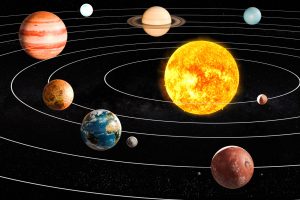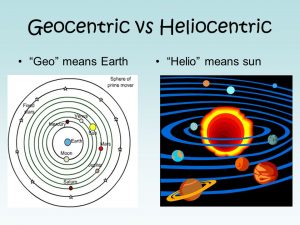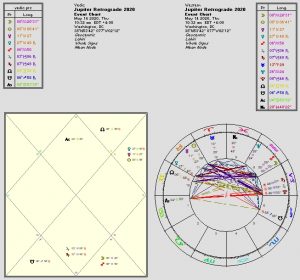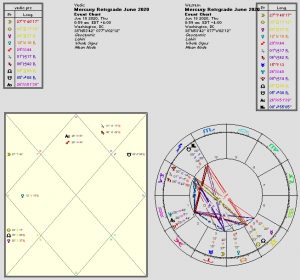During much of May and June 2020, four planets will be retrograde at one time (not including the mean lunar nodes); later in June and through much of the summer, four, five, or six planets will be retrograde at one time. The following retrograde periods are calculated according to the eastern daylight time zone:
- Pluto: April 25 to October 4
- Saturn: May 11 to September 29
- Venus: May 13 to June 25
- Jupiter: May 14 to September 12
- Mercury: June 18 to July 12
- Neptune: June 23 to November 28
Uranus will retrograde later, from August 15 to January 14, 2021. Mars will retrograde later too, from September 9 to November 13, so coming up, and on and off into October and November, we will be in “retrograde season.” According to the birth chart research of late astrologer John McCormick, it is relatively rare to have four, five, or six retrograde planets. Here are McCormick’s findings in terms of these percentages:
- 0 retrograde planets: 7.7 percent
- 1 retrograde planet: 18.7 percent
- 2 retrograde planets: 29.2 percent
- 3 retrograde planets: 26.7 percent
- 4 retrograde planets: 12.7 percent
- 5 retrograde planets: 4.15 percent
- 6 retrograde planets: 0.6 percent
- 7 retrograde planets: 0.005 percent
To appreciate the impact of retrograde planets, we need to first understand the astronomy behind them. Planetary motion is usually in the forward direction (direct), but at particular intervals, and from the perspective of Earth, the planets appear to move backward (retrograde). This apparent alternating motion occurs as a result of the variations in orbital speed among the Earth and other planets.
 The retrograde motion is analogous to what happens when we sit on a stationary or very slowly moving train, and another train speeds by, which can look and feel like we are moving backward. In reality, we have not moved, but the effect is still very real.
The retrograde motion is analogous to what happens when we sit on a stationary or very slowly moving train, and another train speeds by, which can look and feel like we are moving backward. In reality, we have not moved, but the effect is still very real.
In Vedic astrology, a retrograde planet is called “vakri” which means “crooked or bent.” When a planet appears to stop and change direction, this is known as a “planetary station,” which in Vedic astrology is known as “stambhana” or “achala,” both of which are defined as “immoveable” or “still.”
When it appears from the Earth that a planet begins to move backward after its station, this apparent movement is known as a “retrograde motion” and the station a “retrograde station.” When it appears from Earth that a planet is moving forward, this is called “direct motion,” and when it changes direction from retrograde to forward, it is called a “direct station.”
The two lights, the Sun and Moon, do not form stations or appear to travel retrograde in the sky. However, Mercury, Venus, Mars, Jupiter, Saturn, Uranus, Neptune, and Pluto do. The mean lunar nodes are always retrograde, and the true nodes are most often retrograde but occasionally go direct, at which time they are thought to be most powerful.
In either natal or mundane astrology, retrograde and stationary planets are considered to carry more potency than planets in direct motion. The degree and sign of a retrograde or stationary planet can be very significant to a native if it connects with key planets or houses in the natal or progressed birth chart, and likewise if it connects with a dasa ruler. Planets that are retrograde are often considered to be worse for health than when they are direct, as they can represent a weakness of the constitution which can manifest as a health issue in the planet’s dasa. Retrograde planets occupying, ruling or aspecting the 7th house and its lord can point to difficulties in relationship.
In my understanding, a retrograde planet has a more powerful energy on an inward level where its affects can be experienced as more latent. In other words, it may not have overt strength, but it will manifest as a distinct force within a native’s psyche. For a retrograde planet in the birth chart to fully manifest outwardly, it needs to be “brought online” through desire, intention, will power, and effort. Even then, its effects may always remain more subjective, or take longer to actualize in a person’s life than a direct planet.
Retrograde planets in both natal and mundane astrology are more introverted and can slow down the outward development of the matters they influence, especially the matters related to the houses they rule. Retrograde planets, including the mean lunar nodes which are always retrograde, are thought to signify something within our nature that we must overcome or focus on in order to attain whatever it is they represent.
There are several opinions in Jyotish shastra regarding the effects of retrograde planets. Mantresvara (Phaladeepika) taught that a planet becomes powerful and auspicious when retrograde, which he said is akin to being exalted even if the planet is in an enemy sign or debilitated. According to Sage Parasara, a planet’s benefic tendencies are greater when retrograde. The greater the cheshta bala (motional strength), the greater the good of a planet. The cheshta bala is greatest during a planet’s retrograde motion.
A different view is found in Saravali, a great 10th-century commentary by Kalyana Varma, in which retrograde planets are seen as powerful. However, they can be powerful for good or bad. Retrograde benefics confer kingship, and retrograde malefics may lead to misery and “aimless wandering.” Certain astrological classics teach that the dasa of a retrograde planet is fortunate, whereas others state that it will be difficult.
All this confusion and inconsistency about the effect of retrograde planets and the intricacies of the retrograde versus direct movement of planets arises because retrograde planets are making conflicted movements. In other words, they appear to move backward from the Earth’s perspective (geocentric), but they are actually moving forward from the Sun’s perspective (heliocentric). Which is it? It’s both, because we live in duality and we are multi-dimensional beings!
 Note that a retrograde planet is closer to the Earth and further from the Sun, which means it is brighter, thus acting like a beacon that is drawing attention to something it signifies. In a natal chart, a retrograde planet signifies something unique and individualizing about one’s character. To understand the effects of a retrograde planet, it is most important to first note whether it is auspicious or inauspicious due to its house and sign placement, lordship, and the yogas and aspects it forms.
Note that a retrograde planet is closer to the Earth and further from the Sun, which means it is brighter, thus acting like a beacon that is drawing attention to something it signifies. In a natal chart, a retrograde planet signifies something unique and individualizing about one’s character. To understand the effects of a retrograde planet, it is most important to first note whether it is auspicious or inauspicious due to its house and sign placement, lordship, and the yogas and aspects it forms.
Retrograde planets in in birth charts or mundane astrology charts can represent something surprising and of an unexpected nature. Because retrograde planets are closer to the Earth, and because they are crossing one particular area of the zodiac three times via transit, they will have a stronger influence than direct planets, but their affect can be muted, held up, or internalized.
The following are some general statements about the upcoming retrograde season, in terms of what we might expect as an overall trend. Please keep in mind that the retrograde cycle of a planet will affect each of us in unique ways, which can only be determined through a specific reading of the astrological birth chart:
- As retrograde planets are changing direction, in some cases we see that whatever has been happening per the status quo may start to change its course, for either “good or bad” depending on the planet and what it is influencing.
- Imbalances may start to come to light, and it will be a good time to root them out and make modifications or repairs.
- We may find ourselves reassessing our actions and affairs, changing our mind, or changing plans.
- It’s a time when we may need to repeat certain past actions and face unresolved matters (including relationships) that may come back to us to be healed, mended, integrated, or completed.
- We may experience a crisis of faith and need to look more deeply within for insight.
- Some changes may be expected in our professional lives, and just generally, in all areas there may be some new highs and lows, and unusual twists and turns.
- This is a time when we must be prepared for sudden changes and strange or unpredictable happenings related to the retrograde planet itself, and to the house and sign in which the retrograde planet is transiting, and related to the aspects and yogas with which it is involved.
Here are more specific details:
1. Pluto stationed retrograde on April 25 at 0+ degrees of sidereal Capricorn, and will retrograde back over a span of two degrees to its direct station on October 4 at 28+ degrees of sidereal Sagittarius. The retrograde transit magnifies Pluto’s already intense energy of transformation. Some additional key words for Pluto are “upheaval, death, metamorphosis, power, corruption, control, regeneration, and evolution.” These themes are especially prominent now as Pluto is transiting in conjunction with the lords of karma and dharma, Saturn and Jupiter.
Mars will square Pluto from early-August to mid-October and then again in December, which suggests the possibility for political tension and/or martial (military) turmoil. The retrograde cycle of Pluto (and especially the stationary periods/five days either side of its retrograde or direct stations) can trigger some inner or outer pressure to “purge” and reorient ourselves to the shifts that have already been occurring within us and our lives. Retrograde Pluto can also activate an intensification of the current social and economic crisis happening across our planet.
From the psychological point of view, retrograde Pluto makes us go ever deeper to examine the status quo, especially as it relates to our security needs and concerns. It also offers a time to integrate the experiences of the past year. And with Pluto in Uttarashadha nakshatra, it could possibly point to some newfound collective strength that builds up over time, under pressure, and in alignment with higher forces. 2. Saturn will retrograde at 7+ degrees of sidereal Capricorn on May 11, and will station direct at about 1+ degree of sidereal Capricorn on September 29. Saturn is the lord of Vayu, the wind or air element, and in the days before and after Saturn stations, we may experience extreme mood shifts, shocks and surprises, intense weather patterns, or seismic events.
2. Saturn will retrograde at 7+ degrees of sidereal Capricorn on May 11, and will station direct at about 1+ degree of sidereal Capricorn on September 29. Saturn is the lord of Vayu, the wind or air element, and in the days before and after Saturn stations, we may experience extreme mood shifts, shocks and surprises, intense weather patterns, or seismic events.
Saturn represents the focus, discipline, and determination we need to face problems and reorganize our lives in order to make improvements. As the Sat Graha, Planet of Truth, Saturn (especially when retrograde) helps us face the truth which includes the karmic consequences of our past. His lessons are not always easy (and remember that retrograde malefics can be more malefic). That said, Saturn is of great benefit when we are open to learning from our mistakes and overcoming our personal weaknesses.
Saturn is transiting in Uttarashadha nakshatra, which spans from 26 degrees 40 minutes of Sagittarius to 10 degrees of Capricorn, from December 26, 2019 until January 22, 2021. This transit characteristically brings a public health crisis and a lot of tumult for world leaders (as this nakshatra is ruled by Saturn’s enemy, the Sun). It is especially challenging when Saturn is retrograde in this asterism (remember, retrograde malefics tend to be more malefic). 3. Venus will retrograde at 27+ degrees of sidereal Taurus on May 13, and will station direct on June 25 at 11+ degrees of sidereal Taurus. This is a time when we are seeking more inner and outer security; looking within to reassess our values, as to what is really important to focus on, and what is not worth holding onto; to deal with any unresolved matters of the heart; and to reassess, reorganize, and finalize important financial decisions and concerns.
3. Venus will retrograde at 27+ degrees of sidereal Taurus on May 13, and will station direct on June 25 at 11+ degrees of sidereal Taurus. This is a time when we are seeking more inner and outer security; looking within to reassess our values, as to what is really important to focus on, and what is not worth holding onto; to deal with any unresolved matters of the heart; and to reassess, reorganize, and finalize important financial decisions and concerns. 4. Jupiter will retrograde at 3+ degrees of sidereal Capricorn in Uttarashadha nakshatra on May 14, and will move back to station direct in the latter part of Purvashadha nakshatra at 23+ degrees on September 12. Both Uttarashadha and Purvashadha nakshatras are the “Invincible Stars” which bring a focus on problem-solving through bold attitudes and actions.
4. Jupiter will retrograde at 3+ degrees of sidereal Capricorn in Uttarashadha nakshatra on May 14, and will move back to station direct in the latter part of Purvashadha nakshatra at 23+ degrees on September 12. Both Uttarashadha and Purvashadha nakshatras are the “Invincible Stars” which bring a focus on problem-solving through bold attitudes and actions.
As Jupiter represents dharma, purpose, and ideals, his retrograde period provides an opportunity to look within for new philosophical perspective. We may be forced to review and possibly change certain plans especially related to our ambitions, professional matters, economic security, and personal independence, as Jupiter is stationing retrograde in Capricorn and moving back into Sagittarius.
During Jupiter’s retrograde cycle, we may more naturally turn within to expand into Spirit, since Jupiter rules the ether element (akasha). As Vachaspati or “Lord of Speech,” Jupiter’s retrograde retreat can also rouse new forms of self-expression.
In electional Vedic astrology (Muhurta), Jupiter and Venus play a special role as Jupiter rules dharma and good fortune, and Venus relates to vitality, value, and satisfaction. Venus and Jupiter transiting retrograde either separately or at the same time is considered an inauspicious “dosha” in electional astrology. For example, it is not a good time for a wedding, entering a new home, or for establishing a new business venture. There are specific forms of alleviation for this dosha according to classical Muhurta, which you can obtain through a professional Vedic astrology consultation if you have no other choice in your timing. 5. Mercury will retrograde three times in 2020 in air signs (sidereal zodiac). The first cycle occurred in February and March in Aquarius. In this next cycle, Mercury will retrograde on June 18 at 20+ degrees of Gemini, and will station direct on July 12 at 11+ degrees of Gemini. The final Mercury retrograde cycle of 2020 will occur from October 14 to November 3 in Libra. Mercury’s retrograde transits in air signs and especially in Gemini can have a challenging impact on all forms of communication, mental processes, travel, relationships, and on mental, immune, and respiratory health. We may experience more than the usual communication breakdowns, including missed appointments, travel snafus, broken devices, and transportation issues, but this is only likely to be an issue if and when retrograde Mercury is somehow interfacing in a challenging way with our own natal horoscope and planetary cycles.
5. Mercury will retrograde three times in 2020 in air signs (sidereal zodiac). The first cycle occurred in February and March in Aquarius. In this next cycle, Mercury will retrograde on June 18 at 20+ degrees of Gemini, and will station direct on July 12 at 11+ degrees of Gemini. The final Mercury retrograde cycle of 2020 will occur from October 14 to November 3 in Libra. Mercury’s retrograde transits in air signs and especially in Gemini can have a challenging impact on all forms of communication, mental processes, travel, relationships, and on mental, immune, and respiratory health. We may experience more than the usual communication breakdowns, including missed appointments, travel snafus, broken devices, and transportation issues, but this is only likely to be an issue if and when retrograde Mercury is somehow interfacing in a challenging way with our own natal horoscope and planetary cycles. 6. Neptune will retrograde on June 23 right after midnight at 26+ degrees of sidereal Aquarius, and will station direct on November 28 at 24 degrees sidereal Aquarius. Neptune in its higher expression is the planet of divine love, mysteries, and idealism. In its lower expression, it represents illusion, delusion, secrets, and lies. It also relates to the petroleum industry and large-scale socialistic enterprises. Therefore, any and all of these matters could be exposed in a new light (with new understanding) during this retrograde period.
6. Neptune will retrograde on June 23 right after midnight at 26+ degrees of sidereal Aquarius, and will station direct on November 28 at 24 degrees sidereal Aquarius. Neptune in its higher expression is the planet of divine love, mysteries, and idealism. In its lower expression, it represents illusion, delusion, secrets, and lies. It also relates to the petroleum industry and large-scale socialistic enterprises. Therefore, any and all of these matters could be exposed in a new light (with new understanding) during this retrograde period.
This can be a time when we have to face up to reality, as misunderstandings and deceptions will be uncovered when Neptune goes back to expose the truth. It will retrograde in the third house of the U.S. Kelleher chart, which represents the public mood as well as media, travel, and communications. Neptune is transiting and retrograding in Purvabhadrapada nakshatra, which embodies the power of purification but also can exhibit a diabolical quality in its less evolved nature. Neptune also rules viruses, and in a mundane chart, the third house relates to vitality (life and death) and specifically signifies respiratory health and disease, so the coronavirus pandemic is probably not going to be finished for a while. We mustn’t fear retrograde planets and planetary cycles because they represent the karma we are here to learn and grow through, and as the retrograde transits provide a time to regroup and reassess where we are and where we want to be going. It’s also important to remember as mentioned before that from the perspective of the Sun (the source of our being), there are no retrograde planets.
We mustn’t fear retrograde planets and planetary cycles because they represent the karma we are here to learn and grow through, and as the retrograde transits provide a time to regroup and reassess where we are and where we want to be going. It’s also important to remember as mentioned before that from the perspective of the Sun (the source of our being), there are no retrograde planets.
To me, this means it’s all about our perspective as to how we navigate retrograde planets and transiting planetary cycles. When we stay within our hearts (the Sun), we align with a much greater understanding of this world and our highest purpose here, which is to awaken and evolve into our true nature as eternal souls in this dance of life; to shine our light and serve the Divine Plan in everything we do; and to always remember that we are made of love.
Thus you learn that the way in which you create a more conscious universe is by being a more conscious being; the way you create a more loving universe is by being a more loving being; the way you create a universe in which humanity once again has the choice to recognize its source, is by living a life which acknowledges that source. (Ram Dass)

